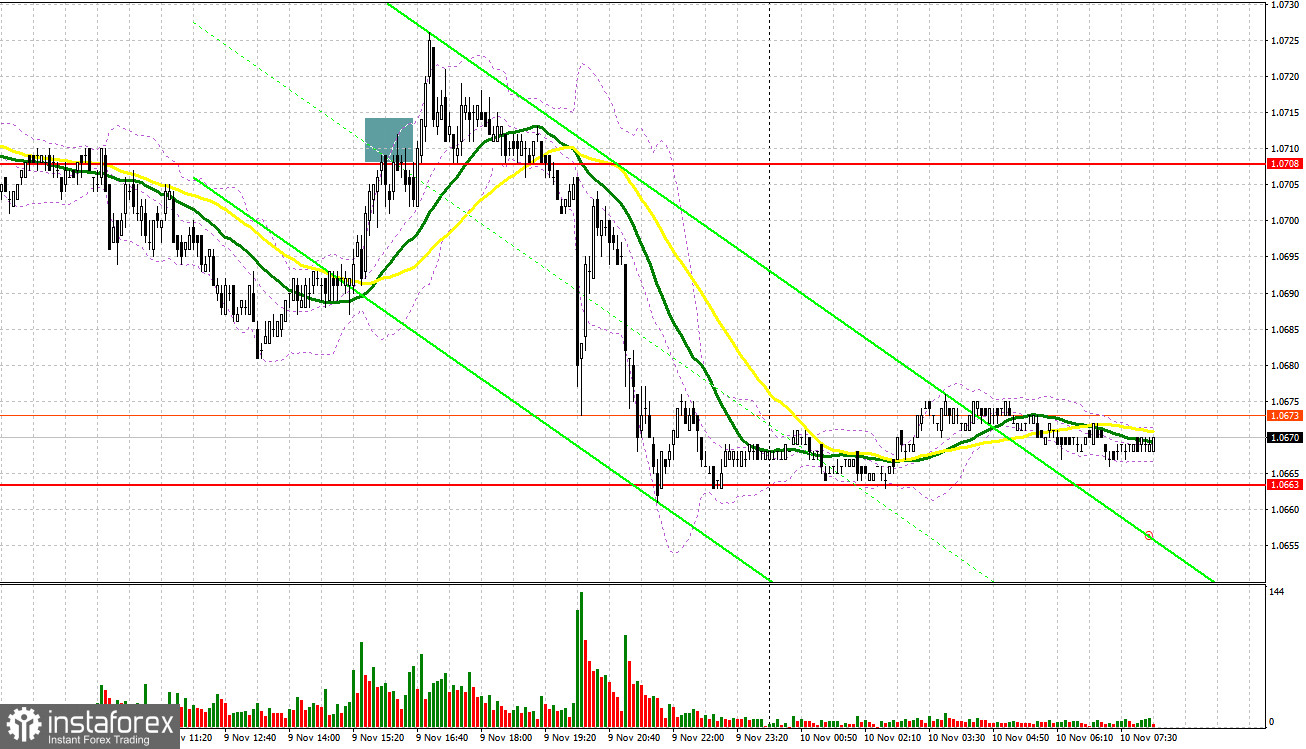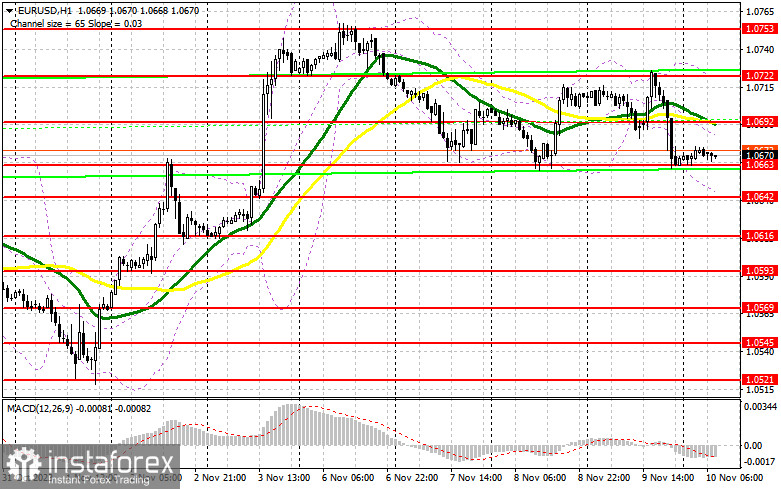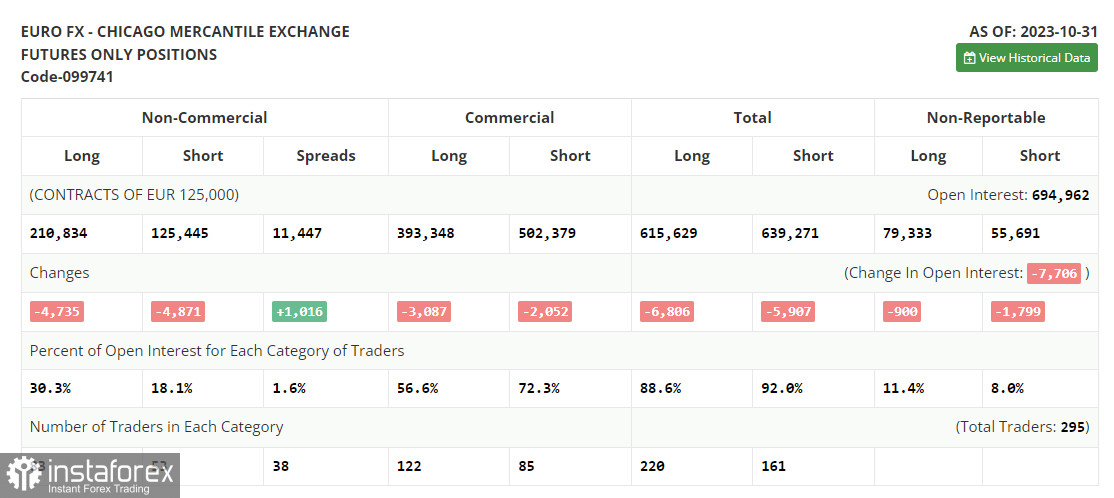Yesterday, only one market entry signal was formed. Let's have a look at what happened on the 5-minute chart. In my morning review, I mentioned the level of 1.0690 as a possible entry point. The price fell to 1.0690, but a false breakout was not formed on this mark, so there was no entry signal. In the afternoon, a false breakout at 1.0708 produced a sell signal, but the pair only fell after the market triggered the stop orders, so I was forced to take losses.

For long positions on EUR/USD:
Yesterday, Federal Reserve Chairman Jerome Powell's speech sent risk assets, including the euro, tumbling. Powell spoke to the panel on monetary policy, and surprisingly his remarks were different from the one that was announced just over a week ago. He said that the Fed would not hesitate to tighten more if needed to curb inflation. Today, the eurozone will not release any economic reports and once again European Central Bank President Christine Lagarde will speak. In case her remarks exert pressure on the pair, the bulls will have to be active in the area of a very important support at 1.0663. A false breakout on this mark will confirm a correct entry point for long positions, in hopes of building an uptrend and that the pair stays in the sideways channel, along with a test of the resistance at 1.0692, which was formed yesterday. This is also in line with the moving averages. A breakout and a downward test of this range will give the euro a chance to surge to 1.0722. The ultimate target will be the area of 1.0753 where I will be taking profits. If EUR/USD declines and there is no activity at 1.0663 in the first half of the day, the pair will be under immense pressure, which will strengthen the bearish correction and may even push the pair down to 1.0642. In such a case, only a false breakout on this mark will provide a buy signal. I will be opening long positions on a rebound immediately from 1.0616 with the aim of an upward correction of 30-35 pips within the day.
For short positions on EUR/USD:
Yesterday, sellers quickly took the chance and brought the pair back to the area of the weekly low. To develop a new bear market, it is necessary to defend the nearest resistance at 1.0692 and break below 1.0663. If the pair rises on Lagarde's statements, a false breakout at 1.0692 will give a good sell signal to continue the downward correction to the support at 1.0663, which has been tested three times recently. Only after a breakout and consolidation below this range, as well as its upward retest, do I expect to receive another signal to sell the pair with a target at 1.0642. The ultimate target will be the 1.0616 low where I will be taking profits. In the event of an upward movement in EUR/USD during the European session and the absence of bears at 1.0692, bulls will return to the market in an attempt to reach the upper band of the sideways channel at 1.0722. It is also possible to sell at this point but only after a failed consolidation. I will be opening short positions immediately on a rebound from the weekly high of 1.0753 with the aim of a downward correction of 30-35 pips.

COT report:
The COT report for October 31 showed a reduction in both long and short positions. This positioning was ahead of the crucial meeting of the US Federal Reserve, where the regulator decided to maintain its policy unchanged. However, weaker US labor market data, indicating less robust growth in new jobs, likely led to a more significant realignment of forces, unfortunately not yet reflected in this report. This type of statistics reinforces the idea among investors that the Fed will no longer raise interest rates and that the aggressive policy could be concluded as early as the beginning of next summer. This will continue to put pressure on the US dollar and lead to the strengthening of risk assets. According to the latest COT report, non-commercial long positions decreased by 4,735 to 210,834, while non-commercial short positions fell by 4,871 to stand at 125,445. As a result, the spread between long and short positions increased by 1,016. The closing price went down to 1.0603 from 1.0613.

Indicator signals:
Moving averages:
The instrument is trading below the 30 and 50-day moving averages. It indicates that EUR/USD is likely to decline lower.
Please note that the time period and levels of the moving averages are analyzed only for the H1 chart, which differs from the general definition of the classic daily moving averages on the D1 chart.
Bollinger Bands
If EUR/USD declines, the indicator's lower border near 1.0645 will serve as support.
Description of indicators:
• A moving average of a 50-day period determines the current trend by smoothing volatility and noise; marked in yellow on the chart;
• A moving average of a 30-day period determines the current trend by smoothing volatility and noise; marked in green on the chart;
• MACD Indicator (Moving Average Convergence/Divergence) Fast EMA with a 12-day period; Slow EMA with a 26-day period. SMA with a 9-day period;
• Bollinger Bands: 20-day period;
• Non-commercial traders are speculators such as individual traders, hedge funds, and large institutions who use the futures market for speculative purposes and meet certain requirements;
• Long non-commercial positions represent the total number of long positions opened by non-commercial traders;
• Short non-commercial positions represent the total number of short positions opened by non-commercial traders;
• The non-commercial net position is the difference between short and long positions of non-commercial traders.





















